Planning a 3-day Ireland itinerary can be a pain in the backside… So, I’ve done all of the hard work for you!
I’ve spent 25+ years travelling around Ireland and the itinerary below leans on that experience and the many mistakes that I made along the way!
Below, you’ll find 3 different itineraries that have been:
- Meticulously planned
- Tried-and-tested
- Created to follow logical routes
Who these itineraries will suit
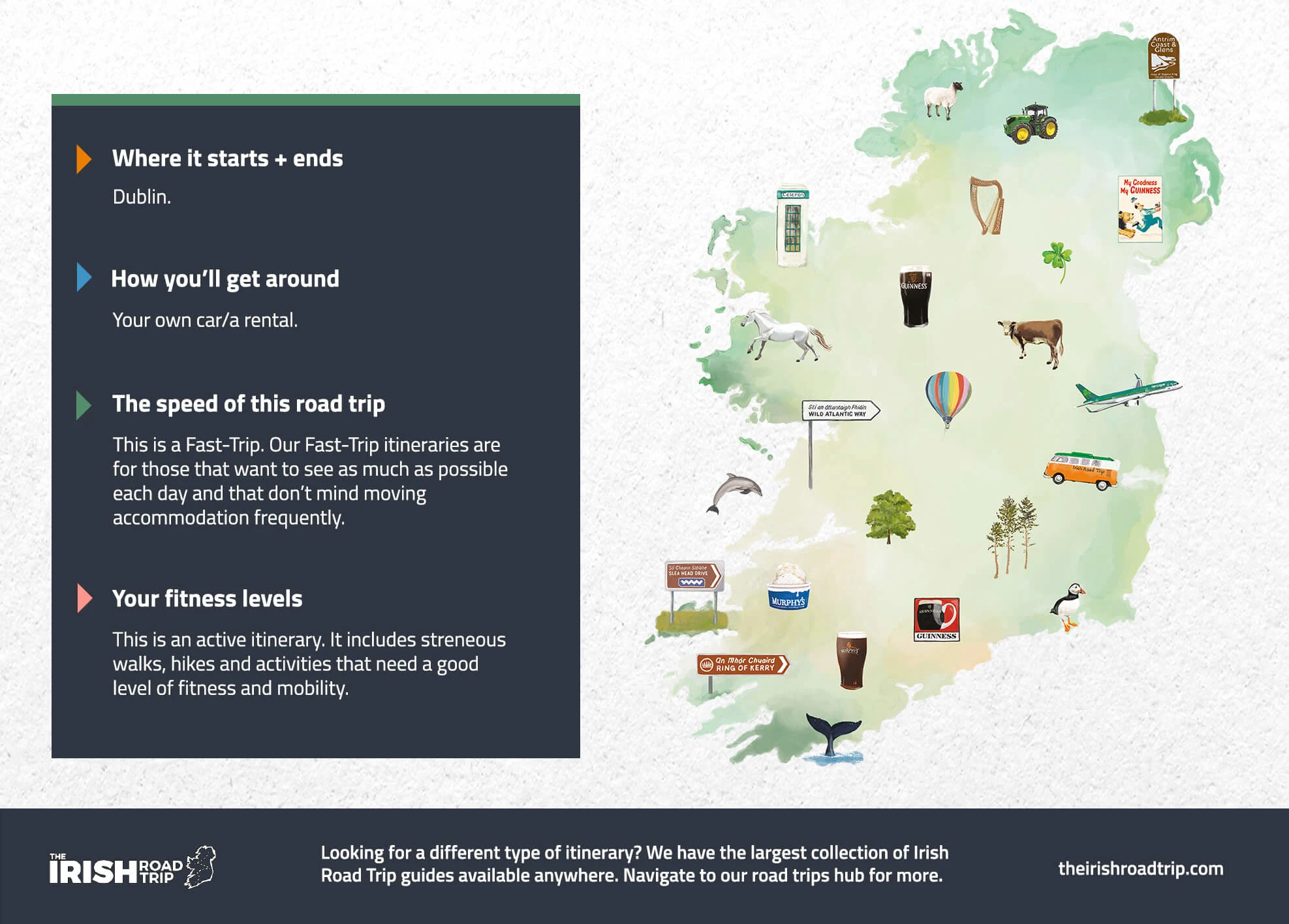
Now, before you scroll down, take 10 seconds to look at the graphic above – each of our road trip itineraries have been tailored to specific needs.
These road trips are specifically for those of you:
- Start point: In/near Dublin
- Time to play with: You have a full 3 days to work with
- Mode of transport: You’ll need a car (if you’re renting a car, read this Irish car rental guide – it’ll save you time and hassle)
- Travel speed: This is a fast-paced itinerary
- Fitness levels needed: Good – it includes walks
- Need a different itinerary? I have many variations of this trip length here
Why trust these guides

I have spent the last 25+ years travelling around Ireland and have dedicated the last 10 to writing what is now The Irish Road Trip Guide.
While the image above will give you a sense of some of the feedback that I receive, this is a drop in the ocean – these hand-crafted itineraries are used by tens of thousands of people every year with nothing but A+ feedback.
Itinerary 1: The logical route

I call this ‘the logical route’ as it really is the most sensible use of your 3 days in Ireland.
It uses Dublin as a base so you don’t waste time moving accommodation and it takes well-planned out day trips that are packed with scenery and historical sites.
3 days is a tiny amount of time to try and see Ireland – I’m strongly of the opinion that you’re better off picking a base and exploring nearby spots, as that’s the best way to make the most of your time.
An overview of the 3 days in Ireland
- Day 1: Arrive in Dublin and explore the city (stay in Dublin)
- Day 2: Day trip to Wicklow (stay in Dublin)
- Day 3: Day trip to the Boyne Valley (stay in Dublin)
Day 1: Arrive in Dublin

Day 1 is going to be very dependent on the time that you arrive into Dublin. If you need to rent a car, I’d recommend collecting one at Dublin Airport via Discover Cars.
While you won’t need it for the first day in the city, it’ll save you having to go and collect one on the morning of day 2.
For this itinerary, I’m going to make an assumption that you’ve landed in the morning and are ready to explore from early-afternoon.
Recommended accommodation in Dublin
- Budget: Abigail’s Hostel (Temple Bar), Jacobs Inn (central hostel) and the Generator Hostel (short walk from the city)
- Mid-range: Dublin Skylon Hotel (just outside the city), Wren Urban Nest (Temple Bar) and the Harding Hotel (very central)
- Luxury: The Merrion (St. Stephen’s Green – very central) and The Westin (just off Grafton Street)
Getting around Dublin + money savers
- Time savers: If you want to avoid walking where possible, it’s worth getting a ticket for the Hop On Hop Off Bus around Dublin. It goes to or near all of the main sites on this itinerary plus plenty more.
- Money saver: If you’re visiting the ‘main’ Dublin attractions, the Dublin Pass can save you €€€ (here’s how)
- The guided walking tour: The local-led Highlights and Hidden Gems Walking Tour immerses you in 1,000 years of history over 2 hours
Stop 1: Lunch
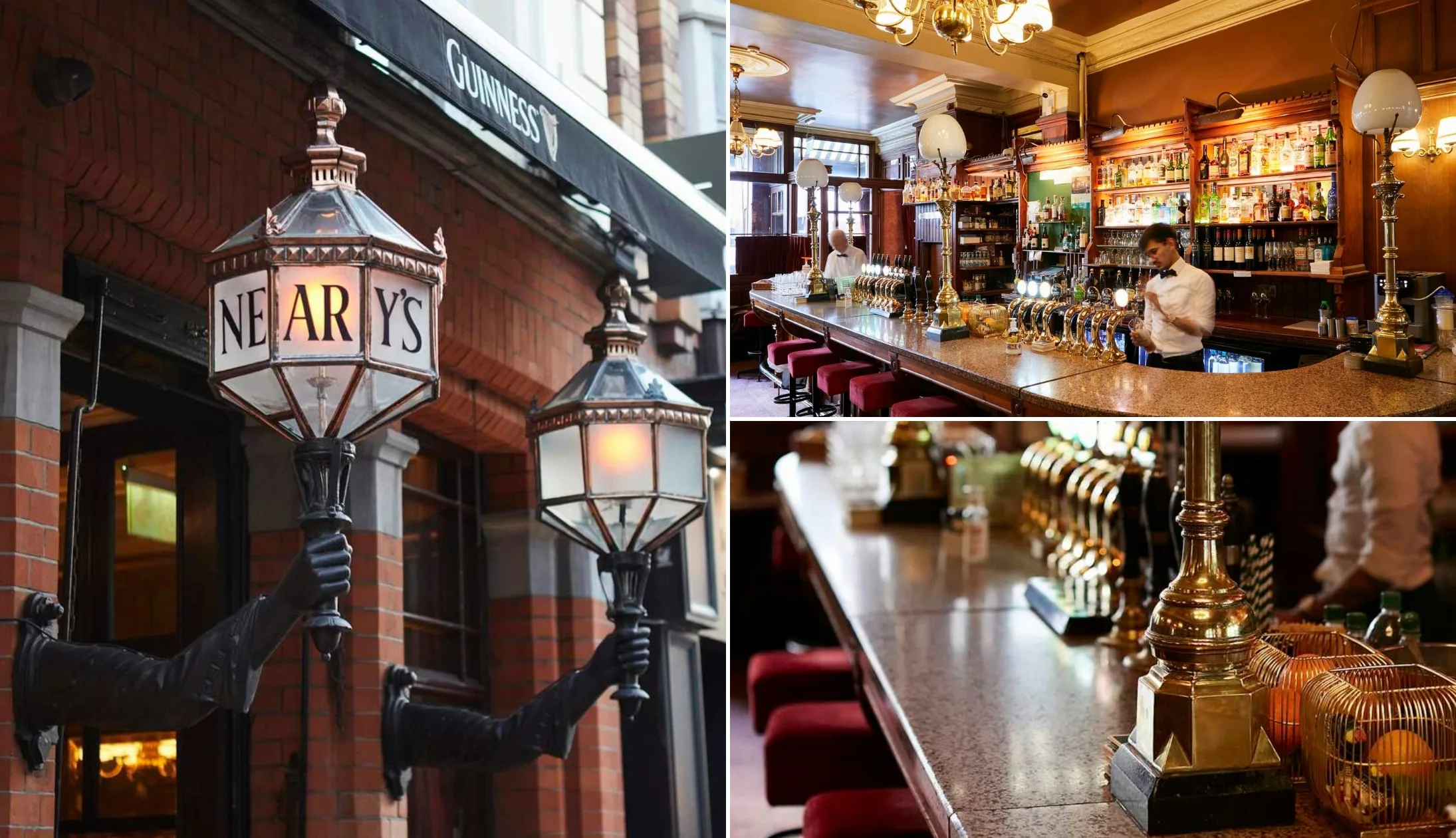
Photos © Tourism Ireland
There are plenty of great restaurants in Dublin that serve up a delicious lunch, but if you fancy a tasty bite in a lovely old-world-style pub, Neary’s (EST. 1887) just off of Grafton Street is hard to bate!
They serve simple dishes (like soups and sandwiches) that are packed with flavour and great value for money. Alternatively, Sprout and Co. on Dawson St. is also a great choice.
They have a range of hearty salad bowls, with good options for vegetarians and vegans.
Stop 2: Trinity College

Now you’re all fuelled up, it’s time to head to Trinity College to see the Book of Kells, arguably the most famous cultural attraction in Dublin.
If you can, I’d highly recommend pre-booking your tickets online, as the queues can get really long (bordering on ridiculous!). This fast-track ticket allows you to dodge the queue and gets you into Dublin Castle, too!
Spend around one hour seeing the Book of Kells, walking around the exhibit, and taking in the beauty of the Old Library. After that, give yourself another 20 minutes or so to walk around the university campus.
Stop 3: The Ha’penny Bridge (via Temple Bar)

The Ha’penny Bridge (officially named the Liffey Bridge) dates back to 1816 and was the first pedestrian bridge over the River Liffey!
It’s a seven-minute walk from the Trinity Gates, but feel free to take your time as you make your way through the lively streets of Temple Bar.
Now, Temple Bar can be a bit of a tourist trap. If you fancy a pint, here are several pubs in Temple Bar worth trying (the Palace is my go-to).
If you feel like an afternoon coffee, there are some great cafes in the Temple Bar area or on the other side of the river. Joe’s Coffee and Vice Coffee are two of my favourites across the water.
They’re both just a short stroll from the north side of the Ha’penny Bridge.
A handy tip for tourists: Struggling to decide when to visit Ireland? Find the pros and cons for each month here
Stop 4: Dublin Castle

Next on the itinerary is Dublin Castle. Nestled in the city centre, the castle dates back to the 13th century and was the seat of the English for over 700 years.
Today, it’s an important government complex and the site of Presidential Inaugurations and key State events. The castle is around 10 minutes from the Ha’penny Bridge on foot.
There’s no admission fee to explore the grounds, but if you want to have a look inside you’ll need to purchase tickets for either a self-guided tour or a guided tour.
Guided tours include access to the State Apartments, Exhibitions, Chapel Royal, and the Mediaeval Undercroft. Self-guided tours include access to the State Apartments and Exhibitions only.
Tickets for guided tours can be purchased on the day of your visit at the ticket booth.
Stop 5: Christ Church Cathedral
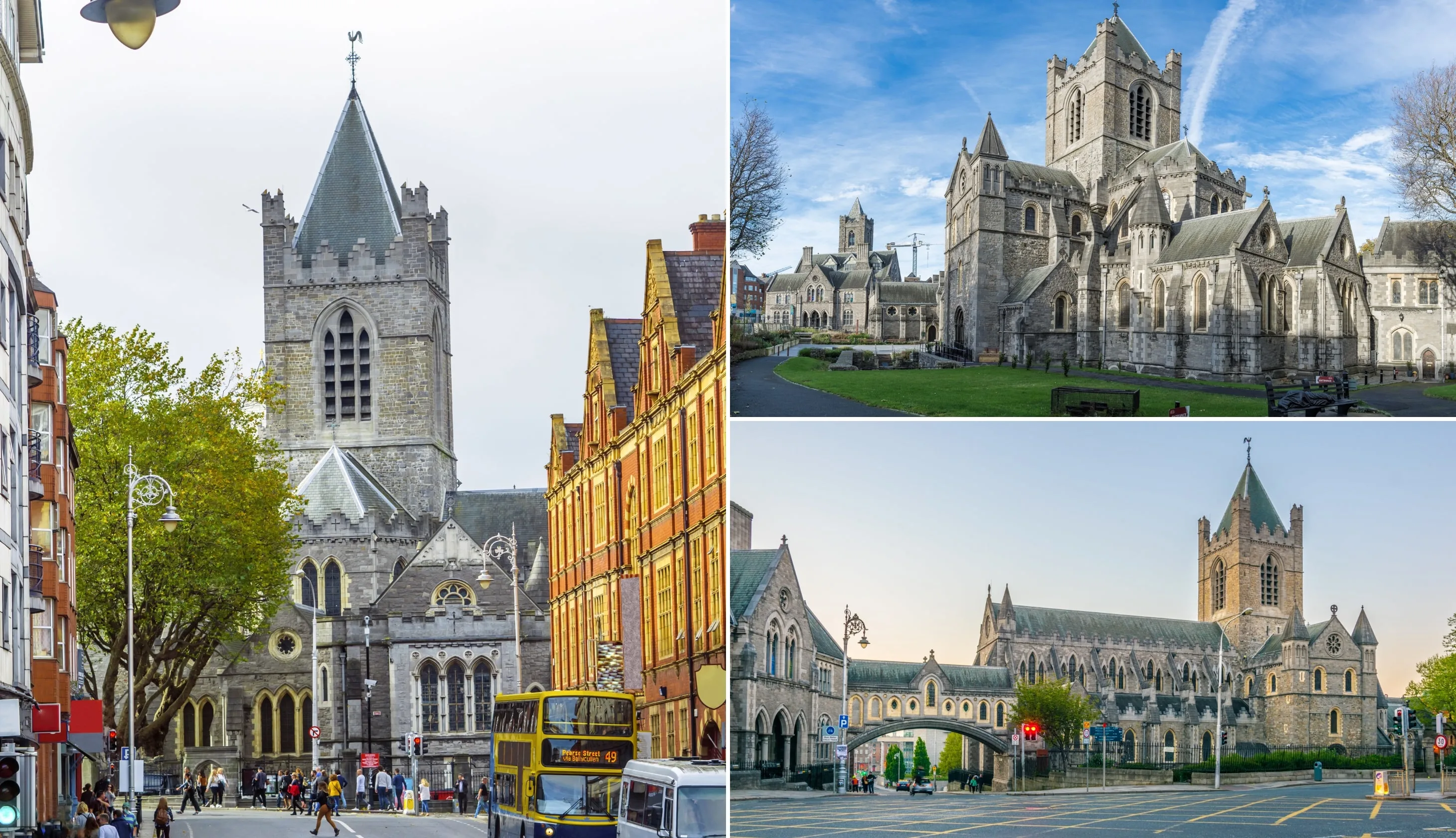
Photos via Shutterstock
Christ Church Cathedral dates back to the early 11th century when it was founded under Sigtrygg Silkbeard, a Norse King of Dublin. It was rebuilt later in stone, largely thanks to the first Anglo-Norman archbishop, John Cumin, in the late 12th century.
The cathedral is only a 4-minute walk from Dublin Castle and a really interesting place to visit. Some highlights are the restored crypt houses, Strongbow’s tomb, and the Treasures of Christ Church exhibition.
You can grab a ticket online here – these include an audio guide that comes in several languages, with three themes to choose from – ‘Power and Politics’, ‘Music and Spirituality’, and ‘Christ Church and the City’.
Self-guided tours with an audio guide usually last around one hour.
Stop 6: The Guinness Storehouse
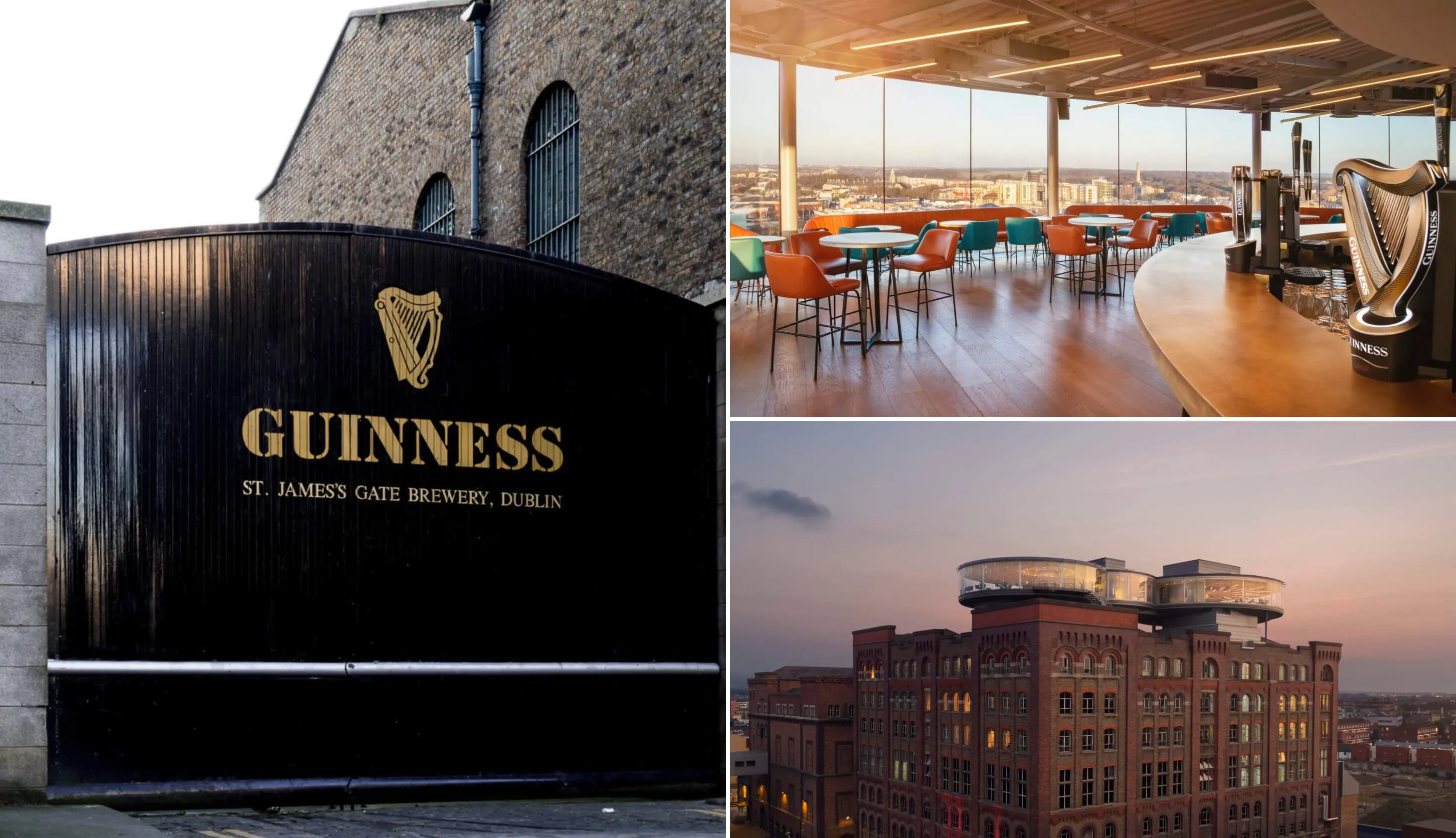
Photos © Diageo via Ireland’s Content Pool
You’re a 20-minute walk from Guinness Storehouse. It’s at St. James’s Gate, the home of Guinness, and there are several tours available.
I’d recommend the Guinness Storehouse Experience, a self-guided tour that takes roughly 90 minutes.
You’ll learn about Guinness’ history, its ingredients, and get to enjoy a pint of Guinness and one other Guinness beer whilst taking in the views of the Gravity Bar.
Stop 7: Dinner, drinks and live music

By now you must be getting hungry. Dublin has heaps of options for dinner and drinks, but I’ve a couple of suggestions for you!
Dinner recommendations
There are some outstanding restaurants in Dublin, with something to tickle most tastebuds.
- My go-to for steak: Hawksmoor (incredible interior, exceptional steak and sublime service)
- My go-to for seafood: SOLE (simply spectacular)
Live music and trad bars
Although I’ve a detailed Dublin pubs guide, my go-tos are Bowes, Kehoes and Neary’s.
There are plenty of live music pubs in Dublin, too, like the Celt, the Old Storehouse and Darkey Kelly’s!
For those that don’t fancy the pub
Skip the pub crawl and enjoy a lively night of traditional music and dance in an intimate 18th-century Dublin townhouse.
The Irish House Party offers dinner, craic, and world-class performers.
Another way that you could spend day 1

If you’ve been to Dublin before, or if you just aren’t that gone on busy cities, you’re in luck – many of the best things to do in Dublin are located a short train ride away.
I’ve outlined a route for you to follow on the map above, but you’ll find the itinerary in detail half way down the page here.
Day 2: Wicklow’s Wonders

On day 2, it’s time to put that rental car to use and head out of Dublin. Today, you’ll be exploring Wicklow, also known as the Garden of Ireland.
There are a few walks on the agenda today, so make sure to bring appropriate clothing and footwear, lots of water and snacks, and a raincoat (just in case!).
Stop 1: Glendalough Visitor Centre and Monastic City
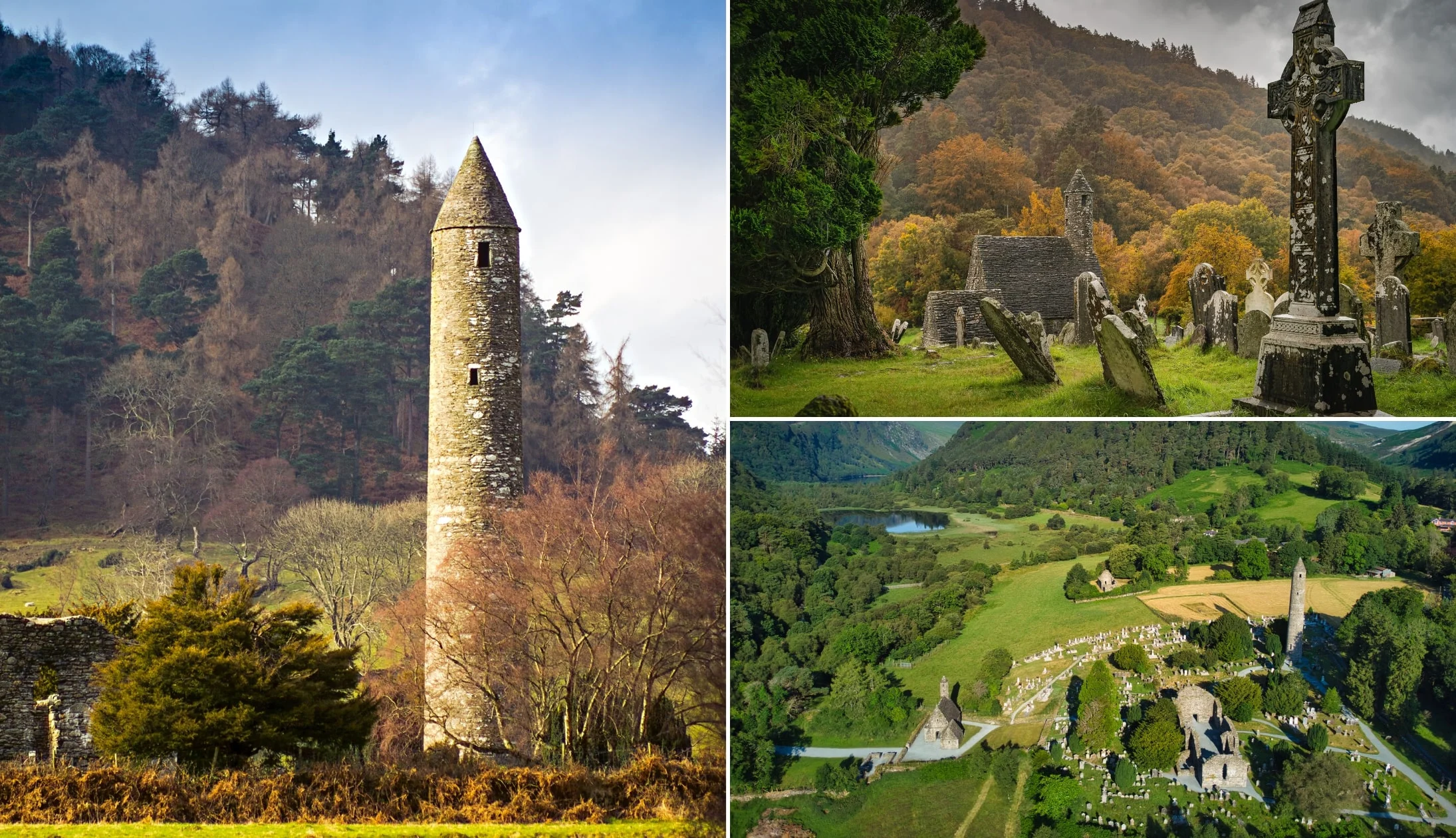
Photos via Shutterstock
Park up at the Glendalough Visitor Centre (the Lower Car Park – €4) and plan to spend between 30 – 45 minutes exploring the centre and the ‘Monastic City’.
The visitor centre is right next to the Monastic City, one of the most important monastic sites in the country. The city was founded by St. Kevin in the 6th century and went on to become one of Europe’s most famous religious sites!
At the centre, there’s a wonderful exhibition on the history of Glendalough and St. Kevin. There’s also an interesting 15-minute long audio and visual presentation about early Irish Saints and monasteries.
Now you’ve learned about the site, it’s time to take a 2-minute stroll to the Monastic City next door. Whilst the remains of the city are scattered all across the glen, many of the main ruins and features are within walking distance of the visitor centre.
These include the Glendalough Round Tower, one of the city’s most well-known landmarks. It stands 33 metres high and dates back almost 1000 years! Other attractions nearby include St. Kevin’s Church and the Glendalough Cathedral ruins.
Stop 2: The Spinc Walk

The Spinc Walk is one of the finest trails in Glendalough. It takes you on a 9.5 km ramble with steep inclines and forest paths.
There’s over 600 steps near the start, but after that, it’s a little more relaxed, though there are some tricky downhill sections later.
It’s a moderate to strenuous walk, with a total ascent of 380 metres. Having said that, if you’re in reasonable shape, you should be okay and most people complete the walk in just over 3.5 hours.
Stop 3: Late lunch at the Wicklow Heather

Photo left: The Irish Road Trip. Others: Via Wicklow Heather
I love nipping into the Wicklow Heather for lunch whenever I’m in Glendalough. The restaurant is in the heart of idyllic Laragh, with a historical interior and some lovely outdoor seating areas.
It’s only a 6-minute drive from the Upper Lake Car Park.
The menu has traditional Irish dishes, like comforting seafood chowder or hearty cottage pies, with an option for vegetarians and vegans.
Stop 4: The Sally Gap Drive (multiple stops)

The glorious Sally Gap Drive is one of Ireland’s finest drives. Aim for Lough Tay, first. Also known as Guinness Lake, Lough Tay is the jewel in Sally Gap’s crown!
From here, follow the winding road down, over the PS I Love You bridge and around until you reach a car park (on your right).
From here, very carefully walk around and get an eyeful of Glenmacnass Waterfall before heading on to Glendalough.
If you’re feeling up for a walk, I’ve got two for you to choose from. There’s the Djouce Mountain Walk and the Ballinastoe Woods Walk, both of which range from 2 to 2.5 hours in length.
Stop 5: Powerscourt Waterfall along with the house and gardens
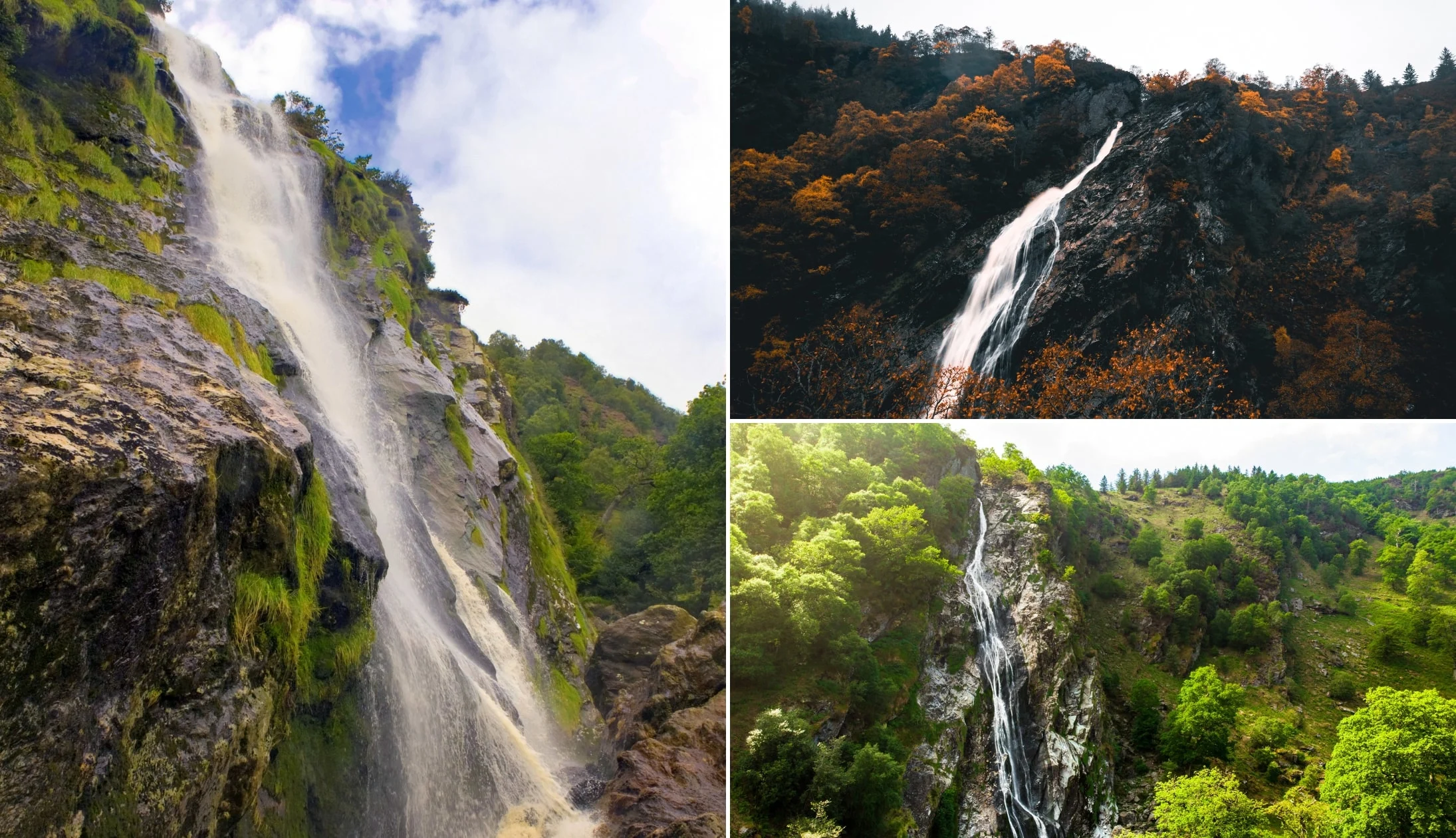
Photos via Shutterstock
Powerscourt Waterfall is a 15-minute spin from where you’ll finish the Sally Gap Drive. This is Ireland’s tallest waterfall at 121m and it roars through ancient woodland alive with red squirrels and Sika deer.
It’s a gentle stroll from the car park out to where you can see the waterfall, so it should be very manageable even after your hike earlier in the day.
A short drive away, Powerscourt House overlooks 47 acres of formal gardens with statues, secret hollows, and sweeping terraces.
The grounds are extensive but you can easily have a coffee in the cafe and then wander at your leisure.
A handy tip for tourists: The weather can make-or-break a trip to Ireland. Here’s a guide to what to expect from each month
Stop 6: Back to Dublin for the night

After a long (and hopefully enjoyable!) day of exploring, it’s time to say goodbye to Wicklow and head back to Dublin.
If you’re still struggling to pick a place/area to stay in the city, see my guide on where to stay in Dublin!
Here are some recommendations for the evening:
- Food: There are some excellent restaurants in Dublin. SOLE and Gallaghers Boxty House are 2 I recommend over and over
- Live music: There are plenty of live music pubs in Dublin. Darkey Kellys, the Old Storehouse and the Celt rarely disappoint
- Historic pubs: From my guide to the best bars in Dublin – Kehoe’s and Neary’s are firm favourites
Day 3: The historic Boyne Valley

Photos via Shutterstock
On day 3, you’ll be heading out to the beautiful Boyne Valley, famous for its archaeological sites.
Today, I’d recommend getting a good breakfast in as there won’t be places to grab a bite near your first stop, so it’s best to eat before you leave Dublin.
Stop 1: Newgrange

Newgrange is a fascinating prehistoric monument and the main attraction in the Brú na Bóinne World Heritage Site. The neolithic passage tomb was built around 3200 BC, making it older than the Egyptian pyramids and Stonehenge!
From Dublin City Centre, it’s around a 45-minute drive (depending on traffic). I’d recommend setting out as early as possible to avoid traffic.
You can book your Newgrange Tour + Exhibition tickets here, pre-booking is essential. Please note, that you cannot go to the monuments directly. You must start at the Brú na Bóinne Visitor Centre. The Newgrange Tour is roughly one hour long.
Stop 2: St Peter’s Church, Drogheda
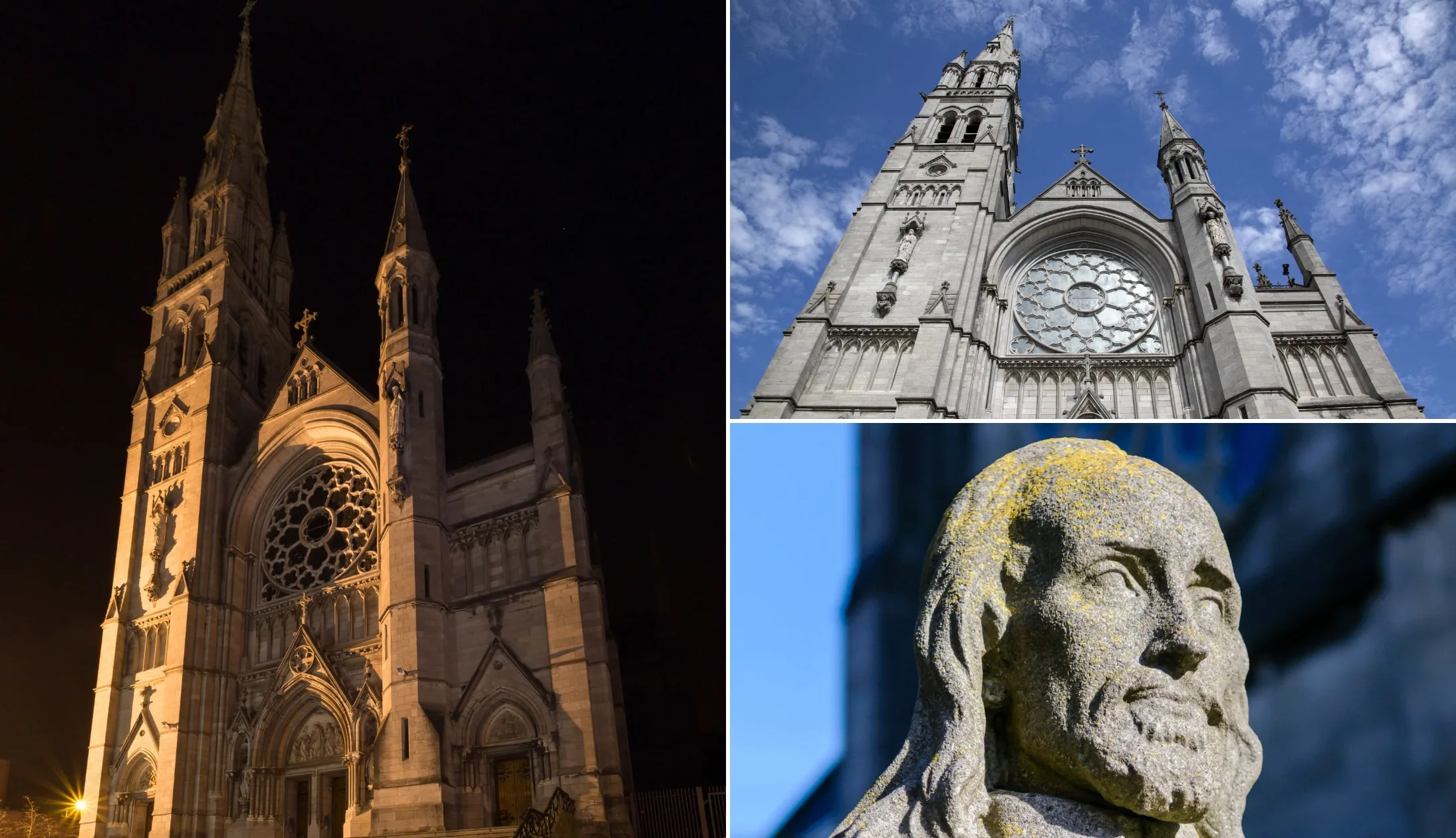
Photos via Shutterstock
Your next stop is St. Peter’s Church, a 15-minute drive from Newgrange. It’s a stunning French Gothic-style church that dates back to 1884.
It’s well known for being home to the national shrine to St. Oliver Plunkett, a Catholic archbishop who was executed in Tyburn, England for treason and “promoting the Roman Faith”.
The shrine is elaborate and detailed and contains the preserved head of St. Oliver Plunkett! Other artefacts on show include his bones and the cell door of his Newgate prison.
Please take care to observe complete silence in the church as it’s a sacred place.
Stop 3: Monasterboice
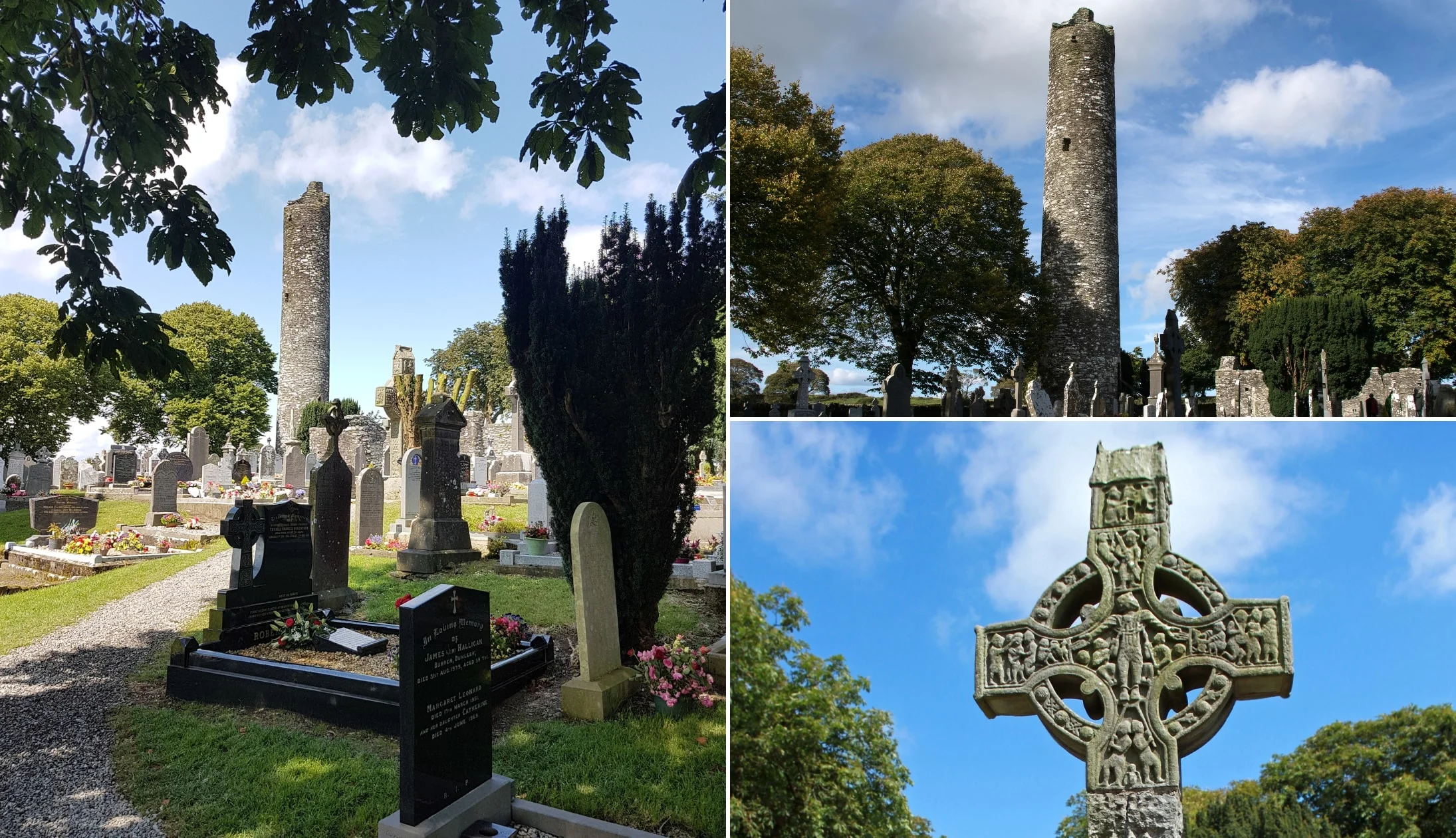
Photos via Shutterstock
Monasterboice is a 12-minute drive from the church. The ruins date back to the late 5th century and were founded by Saint Buithe.
The Christian settlement was an important centre of religion and learning in the area up until 1142 when the Mellifont Abbey was founded.
Highlights of the settlement are the 28-metre round tower, two church ruins, and the magnificent 10th-century high crosses – the Muiredach’s Cross and the West Cross (the tallest in Ireland).
I’d recommend spending around 30 minutes here.
Stop 4: Hill of Slane

Photos via Shutterstock
The Hill of Slane is an incredibly important site, and a possible location for where St. Patrick lit the Paschal Candle, which represented Christianity coming to Ireland.
The site is home to 16th-century Franciscan Monastery ruins, built on top of an older monastery founded by St. Erc, one of St. Patrick’s followers.
It’s a 15-minute drive from Monasterboice, and we’d recommend spending between 30 minutes to an hour here, depending on how much you want to explore.
Stop 5: Lunch in Navan

Photos via The Gate Restaurant on FB
Drive the 25 minutes to Navan to grab a bite of lunch. I’d recommend checking out The Gate Restaurant (a family-run restaurant serving Irish food) or the Crystal Cafe (a great spot for light bites like gourmet sandwiches and wraps).
Room8 (delicious salads and sandwiches – vegetarian and vegan friendly) and Checkov’s Cafe (a cosy spot for sandwiches and salads) are good options, too!
Stop 6: Kells Round Tower and High Crosses
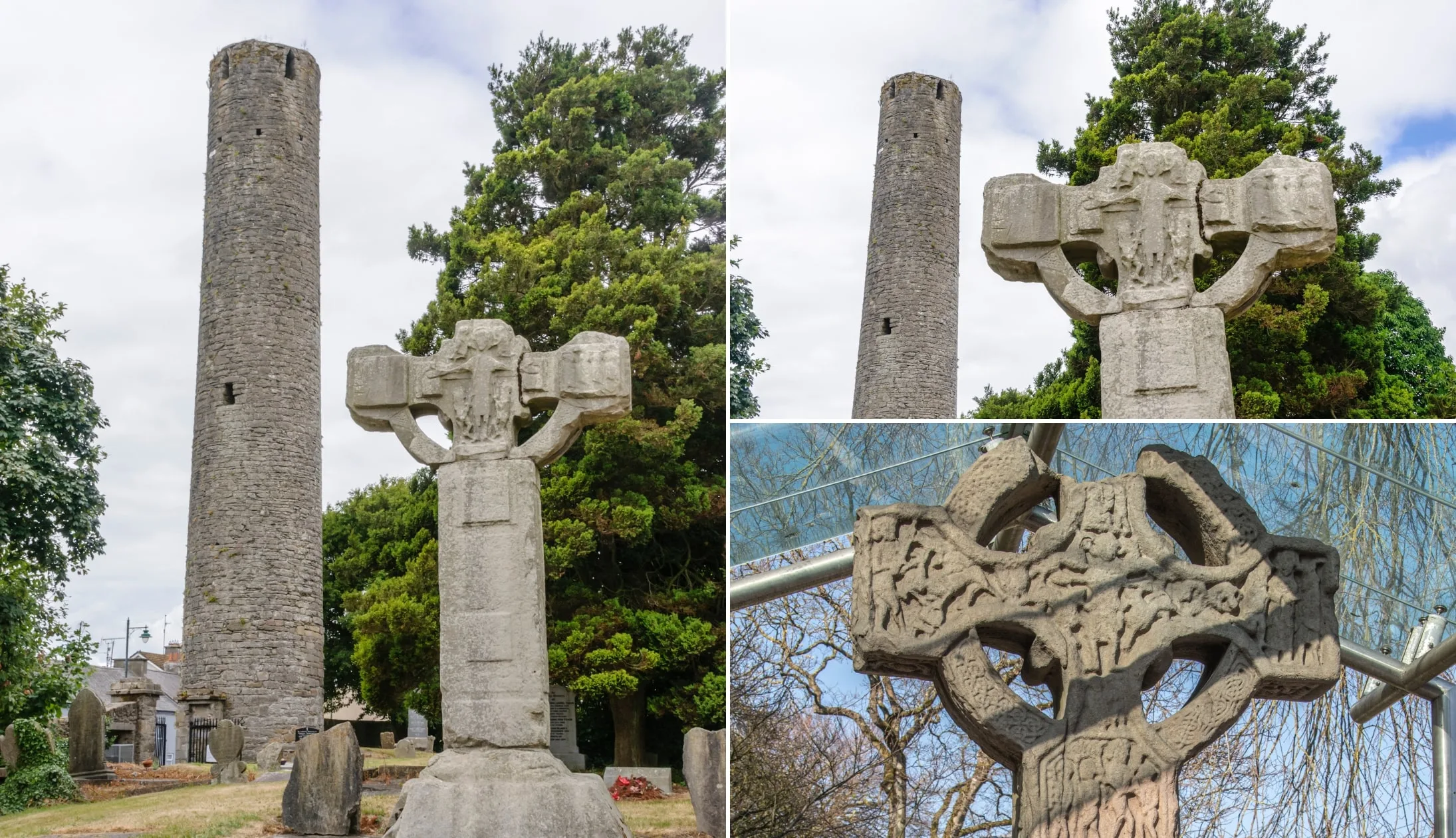
Photos via Shutterstock
Kells Round Tower and High Cross is a 17-minute drive from Navan. The tower and high cross are in the town of Kells, which was founded by Saint Columba in 550 AD.
The round tower is in good condition, but interestingly, unlike other round towers in the country, it has five upper windows instead of four.
Once you’ve had a look at the round tower (it’s 26 metres tall, you can’t miss it!), head over to admire the five high crosses: the South Cross, the West Cross, the East Cross, the Market Cross, and the North Cross (only the base remains).
The South Cross, also known as the Cross of St. Patrick and St. Columba, is the most impressive and in the best condition. It dates back to the 9th century, with intricate carvings of Adam and Eve and Cain and Abel, amongst other things.
Stop 7: Spire of Lloyd
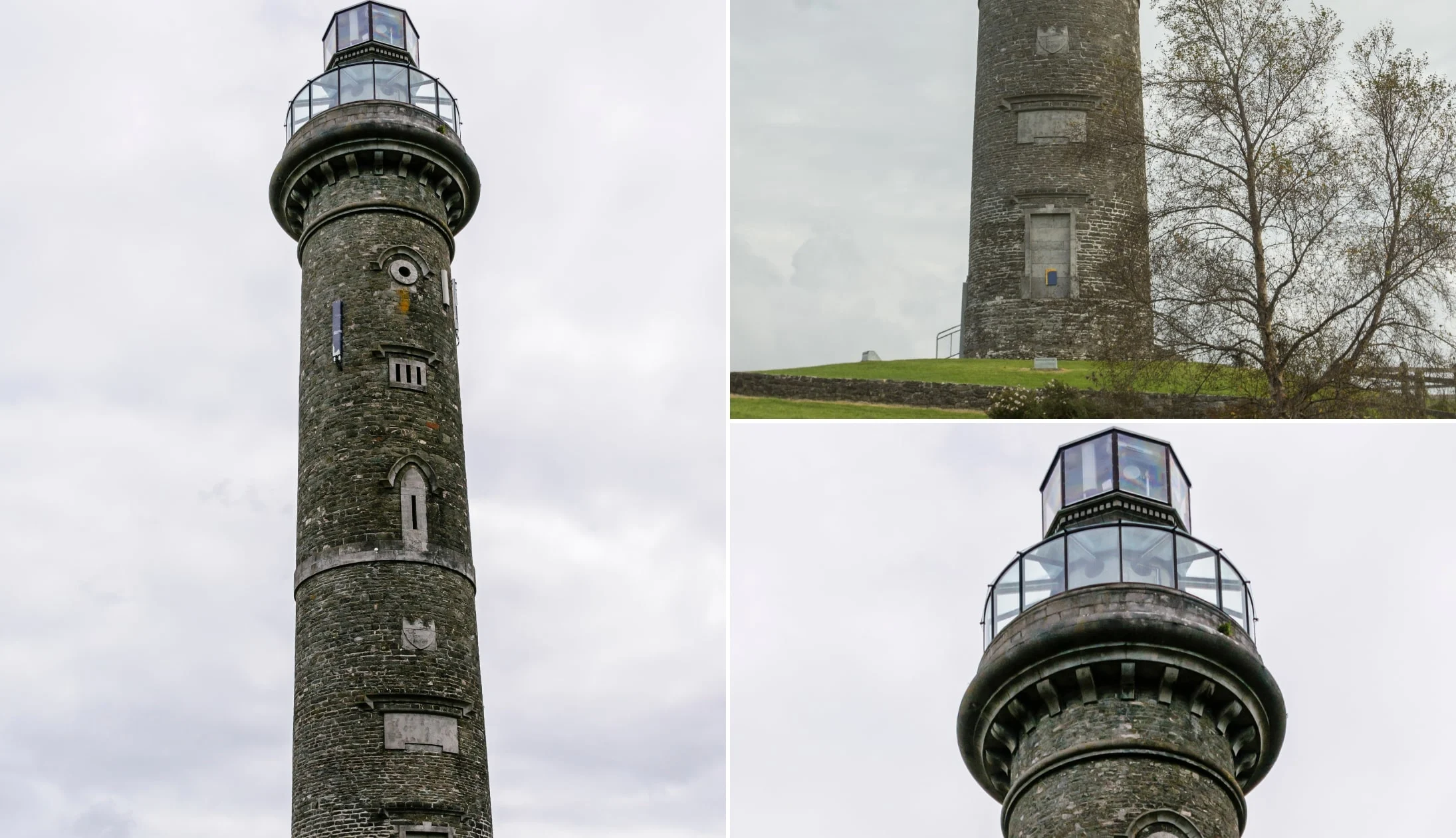
Photos via Shutterstock
The Spire of Lloyd is just a quick 4-minute drive away and an interesting building sometimes referred to as “Ireland’s only inland lighthouse”!
It’s a long column with a 360-degree glass viewing room that is accessed via 164 stairs but please note that it’s rarely open to the public.
The 30-metre spire is said to have been used for watching horse races and hunting in the 19th century, although the racecourse in Kells was built after the tower.
The tower was built in 1791, although it was built on an Iron Age ring fort, with evidence that the site was used as far back as the Bronze Age!
Stop 8: Trim Castle
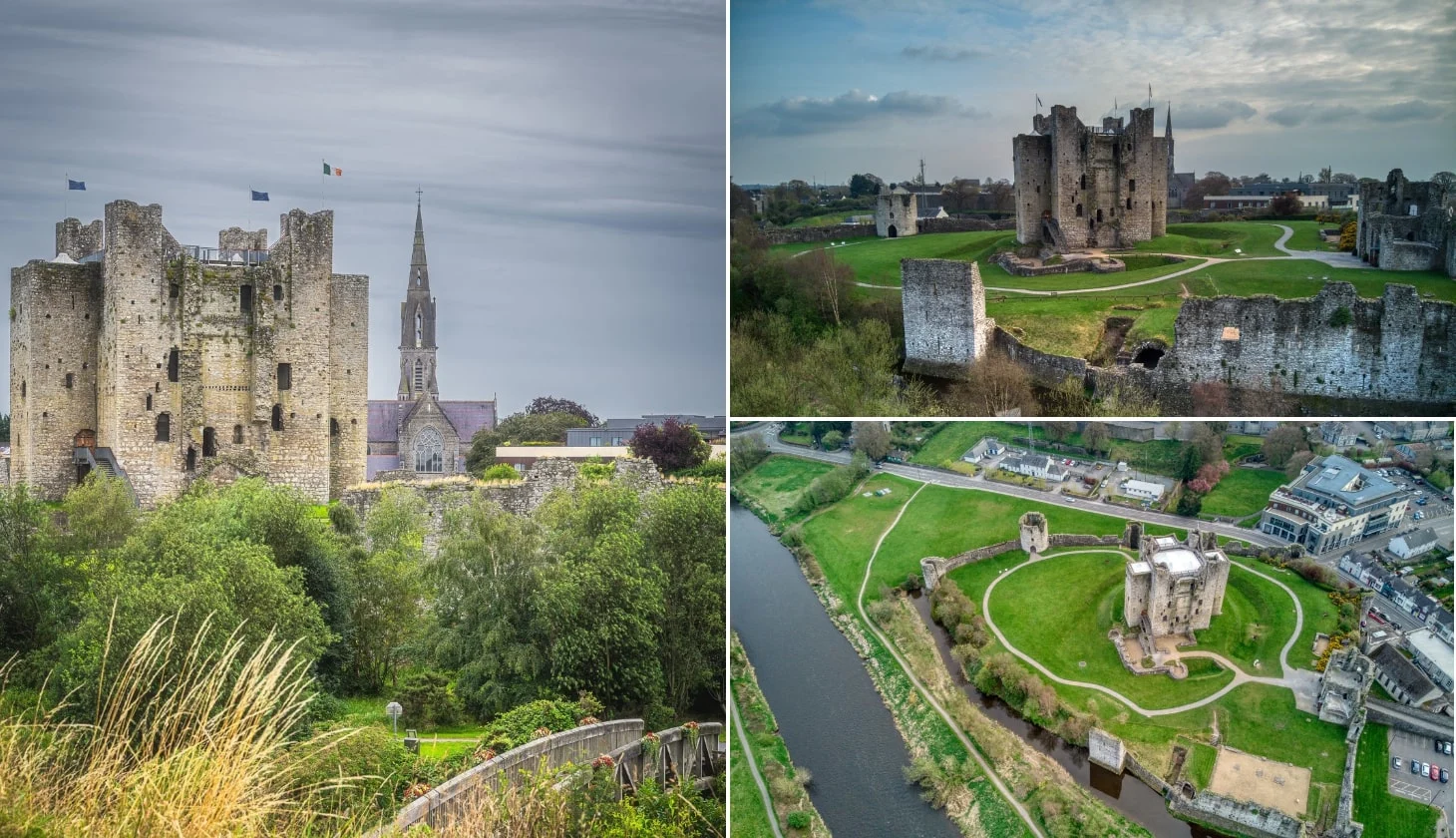
Photos via Shutterstock
Trim Castle is Ireland’s largest Anglo-Norman fortification. It’s very impressive with an imposing presence. The Castle dates back to the 12th century and took Hugh de Lacy and his successors 30 years to complete.
It’s free to visit the castle grounds, but a guided tour of the keep costs €5 (adult), €4 (senior), €3 (student/child), and €13 (family).
The tour is well worth it, especially for any Braveheart fans, as parts of the movie were filmed there!
The castle is open daily between 10am and 5pm. We’d recommend at least 30 minutes to one hour here. It’s a 30-minute drive from the Spire of Lloyd.
Stop 9: Bective Abbey
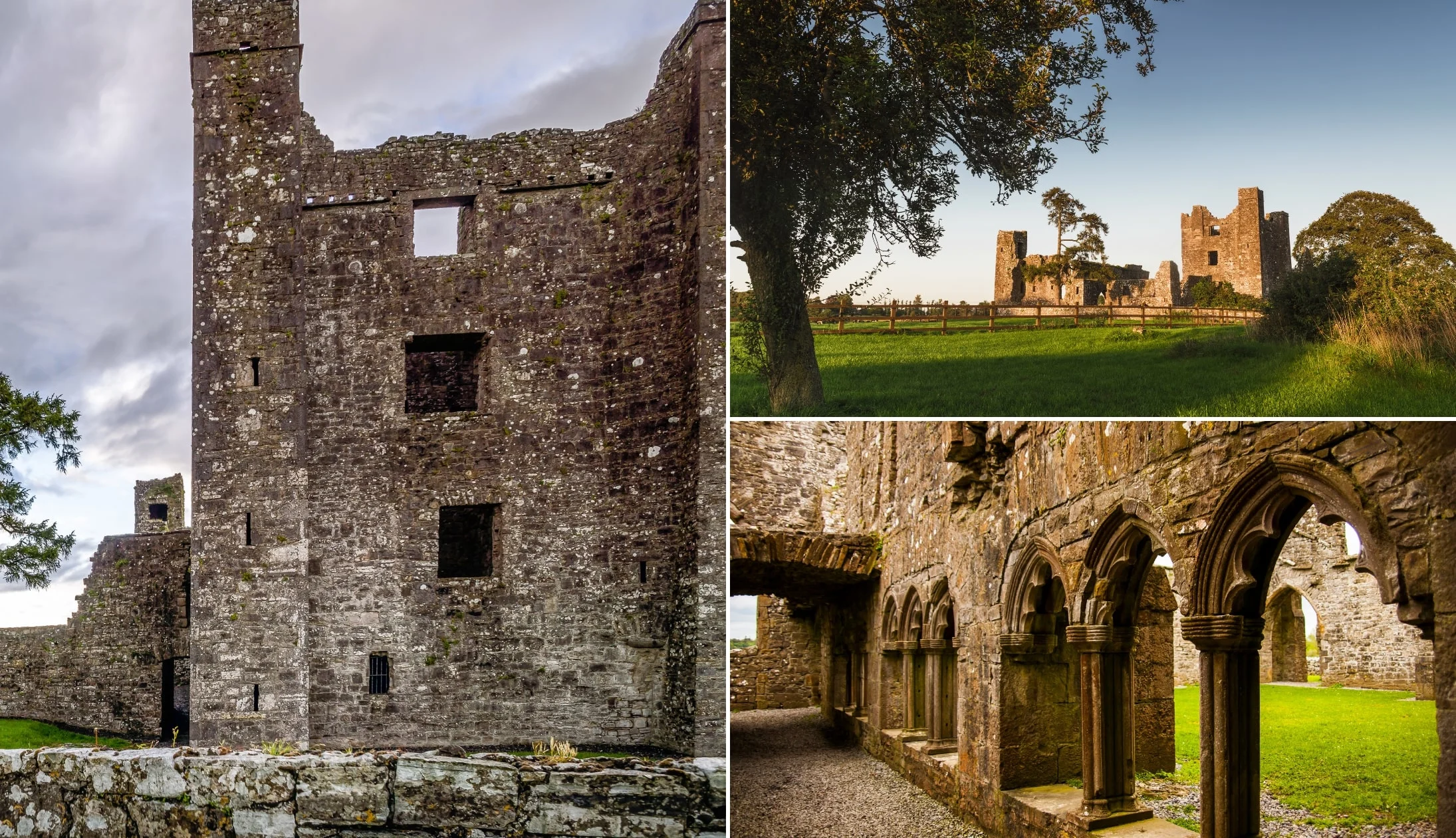
Photos via Shutterstock
The next stop is Bective Abbey, a 10-minute drive away. It was founded in 1147 for the Cistercian Order and became a significant monastic settlement.
The ruins you can see today mostly date back to the 13th and 15th centuries, with a chapter house, a church, and a cloister.
The ruins have been used several times in Hollywood movies. Most recently, in The Last Duel, which came out in 2020.
The abbey is free to visit with a designated car park. Give yourself around 30 minutes here.
Stop 10: Hill of Tara
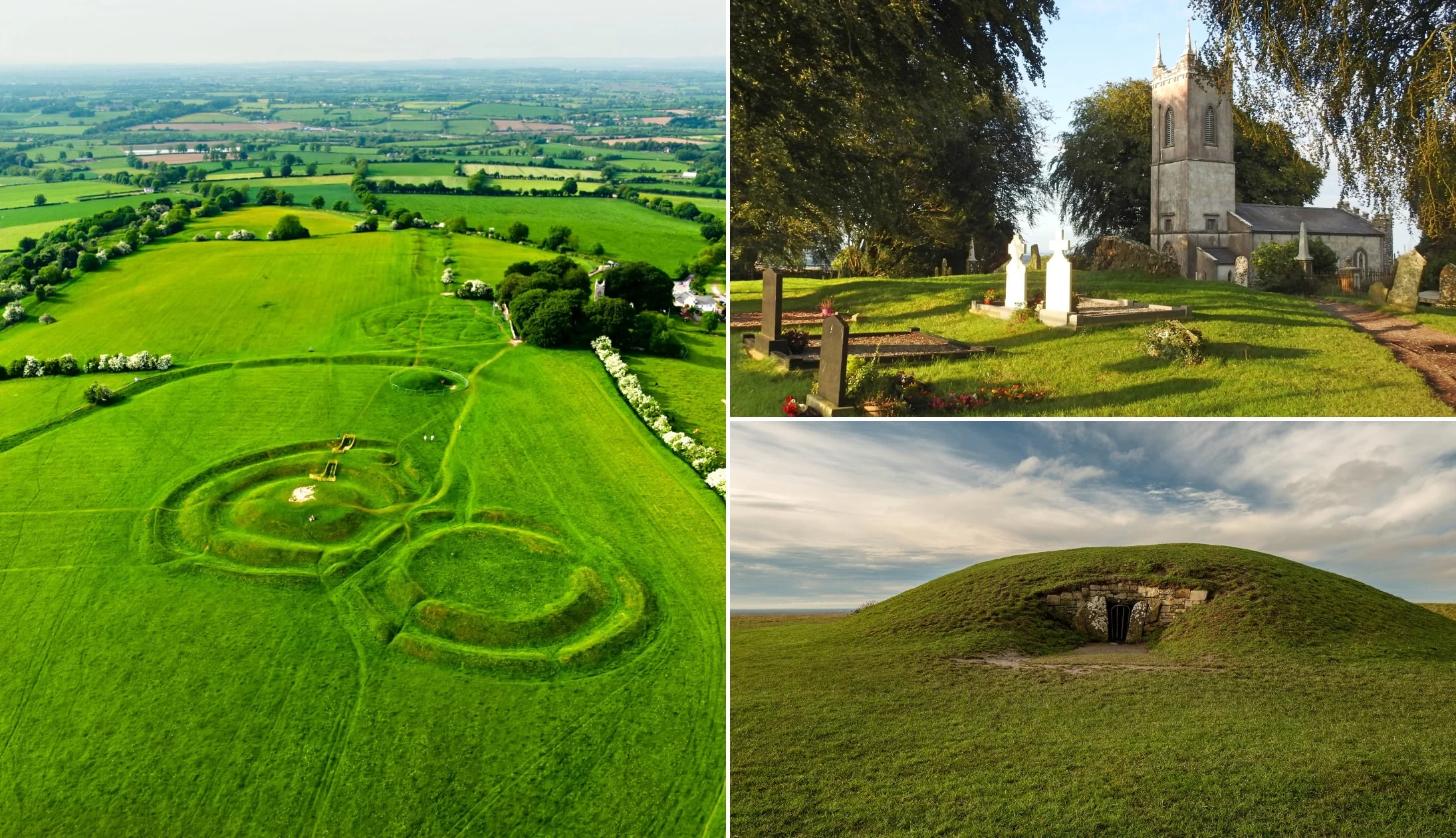
Photos via Shutterstock
The last stop of the day is the Hill of Tara. It’s a 12-minute drive from Bective Abbey and we’d say 30-45 minutes is a good amount of time to spend here.
The Hill of Tara has been in use since the late Stone Age, but it’s known best as the seat of the High Kings of Ireland, with all old Irish roads leading to the site!
The site is shrouded in myth, and the story of Conn of the Hundred Battles tells the tale of how the High Kings of Ireland came to be.
It’s free to visit, with a free 25-minute Audio Visual Show at the visitor centre (in the church), and free guided tours scheduled every day. The centre is open between 10am and 5pm year-round, but the site is open 24/7.
Stop 11: Back to Dublin for the night

From the Hill of Tara, it’s a 50-minute drive back to Dublin City Centre (depending on traffic).
Dinner recommendations
There are some outstanding restaurants in Dublin, with something to tickle most tastebuds.
- My go-to for steak: Hawksmoor (incredible interior, exceptional steak and sublime service)
- My go-to for seafood: SOLE (simply spectacular)
Live music and trad bars
Although I’ve a detailed Dublin pubs guide, my go-tos are Bowes, Kehoes and Neary’s.
There are plenty of live music pubs in Dublin, too, like the Celt, the Old Storehouse and Darkey Kelly’s!
For those that don’t fancy the pub
Skip the pub crawl and enjoy a lively night of traditional music and dance in an intimate 18th-century Dublin townhouse.
The Irish House Party offers dinner, craic, and world-class performers—no hangover required.
Itinerary 2: The busy route

Itinerary 2 is the ‘Busy Route’, though the name’s a bit misleading—it’s only properly busy on Day 3 and even then it’s very managable.
That day takes you from Doolin, up the coast and into Galway City.
An overview of the 3 days in Ireland
- Day 1: Arrive in Dublin and explore the city (stay in Dublin)
- Day 2: Dublin to Doolin via countless historical sites (stay in Doolin)
- Day 3: Doolin to Galway City (stay in Galway)
Day 1: The same as the previous itinerary

As mentioned earlier, all of the Day 1s are the same—you’ll be arriving into the capital, and the route takes in the best things to do in Dublin.
That said, if you fancy mixing it up, I’ve put together some alternative Dublin routes for you:
Day 2: The scenic route to Doolin

Day 2 of this 3 day Ireland itinerary sees you travel to Doolin via a very rewarding route that takes in some of the best castles in Ireland.
Here’s an overview of the route:
- Sallins for coffees (40-min drive): Canal-side town with cosy pubs and great places to eat (park along the canal here – there are cafes nearby)
- Rock of Dunamase (35-min drive): 9th-century castle ruins with glorious views across County Laois
- Rock of Cashel (55-min drive): Hilltop site with 12th-century cathedral and round tower; once the seat of the Kings of Munster
- Limerick (1-hour-and-10-min drive): Lunch and King John’s Castle – a massive riverside fortress with interactive exhibits tracing 800 years of history, from Viking raids to sieges
- Bunratty Castle (20-min drive): Explore this impressive 15th-century tower house and its folk park
- Ennis (25-min drive): Wander the narrow streets of this medieval town and visit the 13th-century Ennis Friary
- Doolin for the night (40-min drive): Check-in and head for food and live music in one of the pubs in Doolin
Day 3: The Clare coast and Galway City
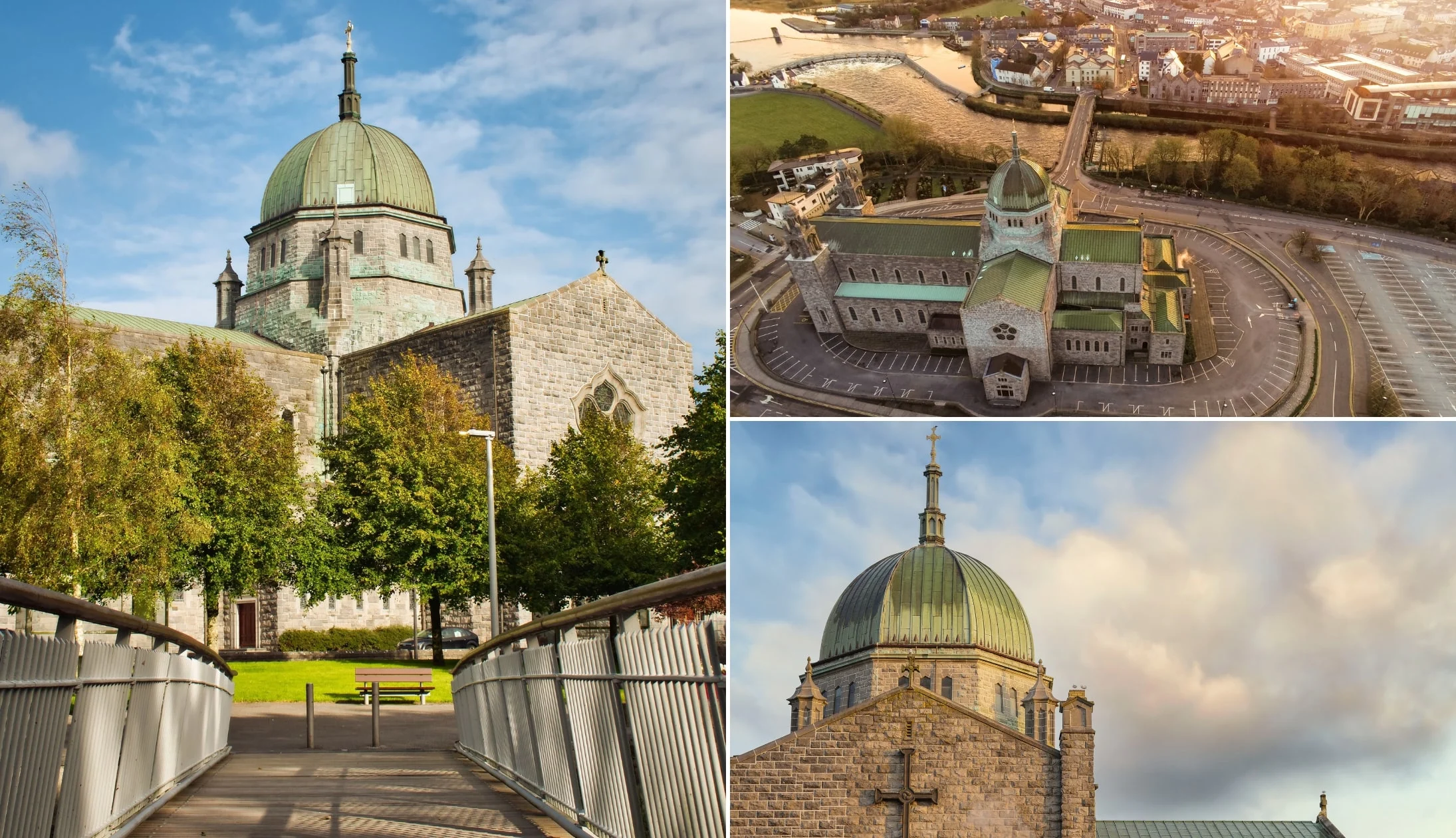
Photos via Shutterstock
Day 3 is arguably the best day of the 3 and it takes you to Moher, first, before following the glorious Clare coast up to Galway City.
This is a relatively easy-going day despite the fact that you cover quite a bit of ground.
Stop 1: The Cliffs of Moher
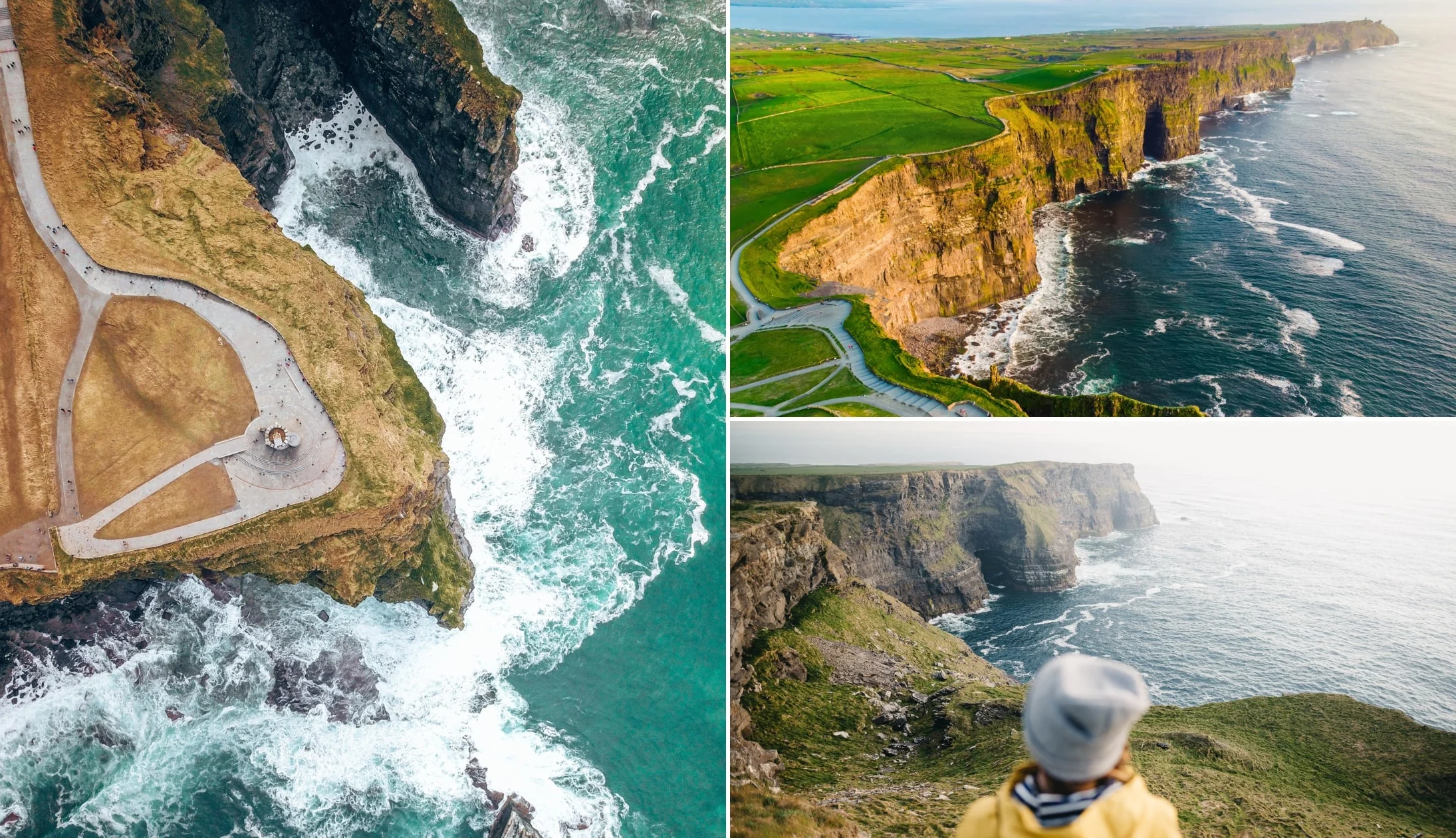
Photos via Shutterstock
Your next stop, the magnificent Cliffs of Moher, are a 15-minute drive from Doonagore.
It’ll quickly become evident why these are one of the most popular things to do in Ireland!
There’s a visitor centre on-site, as well as 800 metres of paved walkways with viewing areas, and the historic O’Brien’s Tower.
In my opinion, the visitor centre isn’t really anything that special, but you’ll get access to all three with the Cliffs of Moher Experience.
Stop 2: The Fanore Viewpoint

When you leave Doolin, you need to follow the R477 road that hugs the coast. You’ll travel along a finely maintained road with the Atlantic on one side and the famous Burren landscape on the other.
The first stop is this viewpoint. Now, as you can see in the photos above, this is accessed by a steep and narrow ‘country’ road.
However, when you reach the top you’ll be treated to glorious views of the Clare coast and beyond.
The fun really begins when you drive back down the way you came – it almost feels like you’re driving into the sea.
This is also a great viewpoint – on clear days you’ll be able to see everywhere from the Aran Islands to the hills of Connemara.
Stop 3: Corcomroe Abbey
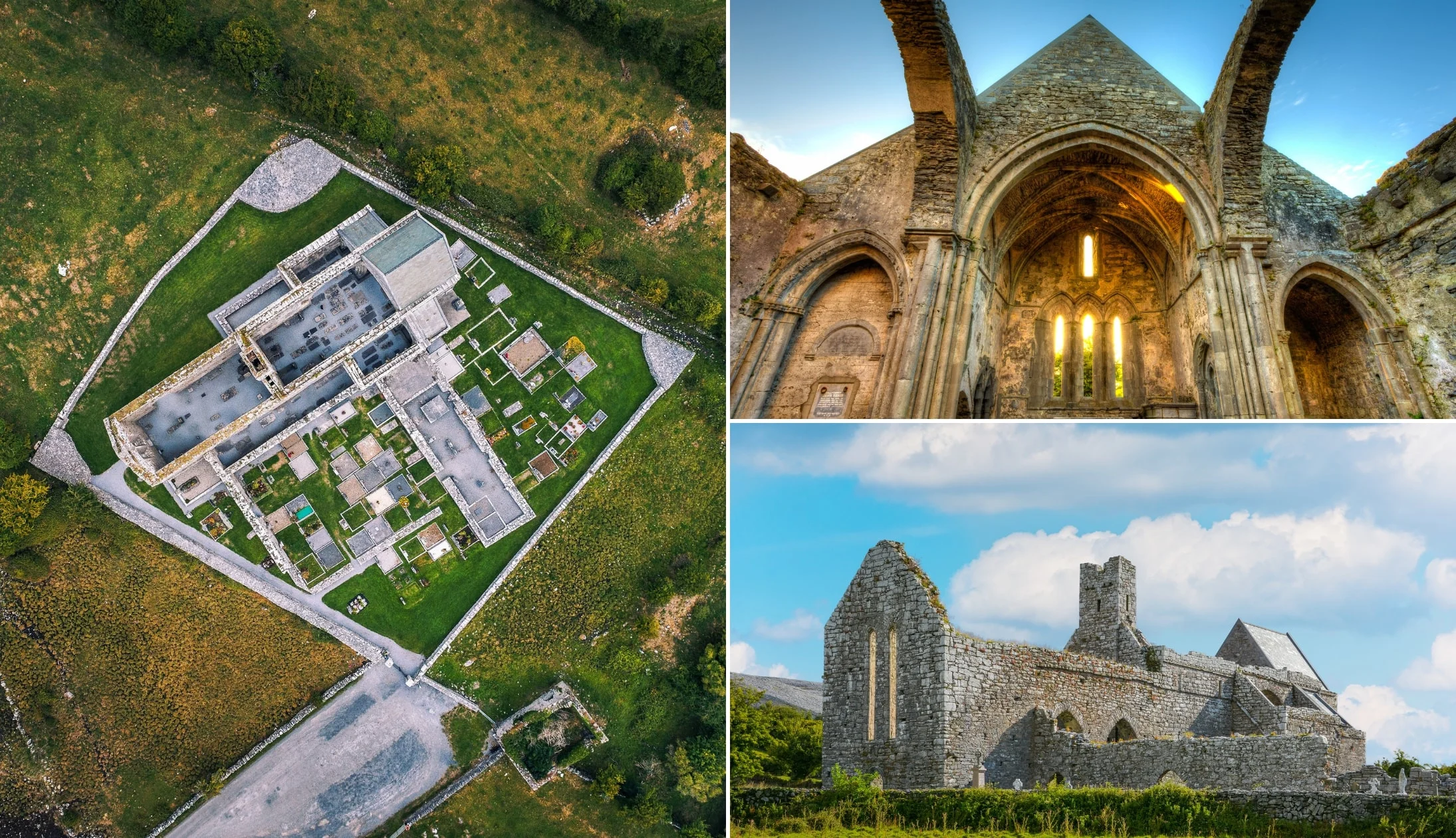
Photos via Shutterstock
Nestled in the heart of the Burren, Corcomroe Abbey—once known as “St. Mary of the Fertile Rock”—dates back to the early 13th century.
Built using local limestone, this Gothic ruin features some of the finest stone carvings of any Irish Cistercian church.
Despite its peaceful setting today, Corcomroe witnessed historic battles, including the burial of King Conor O’Brien after his defeat in 1268.
Now a National Monument, this abbey remains a must-see for history and architecture lovers!
Stop 4: Dunguaire Castle

The final stop before heading into Galway City is Dunguaire Castle. This 75-feet-tall tower house was built in the 16th-century on the shores of glorious Galway Bay, not far from the town of Kinvara.
It was built by the powerful Ó hEidhin clan and it was once owned by the King of Connacht. During the summer, the castle opens for tours.
If you visit during the off season, you can still park across the road and admire it from the outside.
When you finish up, you’re a 40-minute drive to Galway City Centre.
Stop 5: Galway City

When you arrive into Galway City, check-in to your accommodation and then head out for lunch.
The best spot for a casual feed in the city, in my opinion, is Dela – regardless of whether it’s breakfast or lunch.
When you’re fuelled up, it’s time to explore. You have 3 options:
- Option 1: Follow my self guided Galway City walking tour (above)
- Option 2: Take the Galway hop-on/hop-off bus (handy if it’s raining/if you’re tired)
- Option 3: Take this guided walking tour or the excellent Dark History Walking tour
Stop 6: Galway for dinner, drinks and live music

You’ve a night in Galway to look forward to! Here are some recommendations for you:
Dinner recommendations
There are some outstanding restaurants in Galway, with something to tickle most tastebuds.
- My go-tos: Dela (outstanding Irish food) and Ard Bia at Nimmos (beautifully presented dishes that never fail to delight)
- Casual spots: The Dough Bros (Galway’s best pizza) and McDonagh’s (mighty fish and chips)
Live music and trad bars
You’ve some tough decisions to make when it comes to the Pubs in Galway as there’s some fine choice!
In the map above, you’ll find my go-tos.
For those that don’t fancy the pub
Skip the pub crawl and enjoy a lively night at Ireland’s #1 music and dance show in nearby Salthill.
It features performers from Riverdance and The Chieftains and it promises a great alternative to the pub.
Itinerary 3: The mad route

I call this ‘the Mad Route’ as you cover a lot of ground. However, it’s still very manageable if you’re happy to do a good bit of driving.
The first day is nice and handy. The second, when you travel to Killarney, is broken up with several stops, so you won’t be stuck in the car for too long. On the third, you’ll explore the Ring of Kerry.
An overview of the 3 days in Ireland
- Day 1: Arrive in Dublin and explore the city (stay in Dublin)
- Day 2: Killarney via several historical sites (stay in Killarney)
- Day 3: The Ring of Kerry (stay in Killarney)
Day 1: The same as the previous itinerary

As mentioned earlier, all of the Day 1s are the same—you’ll be arriving into the capital, and the route takes in the best things to do in Dublin.
That said, if you fancy mixing it up, I’ve put together some alternative Dublin routes for you:
Day 2: Killarney via a whole lot of history
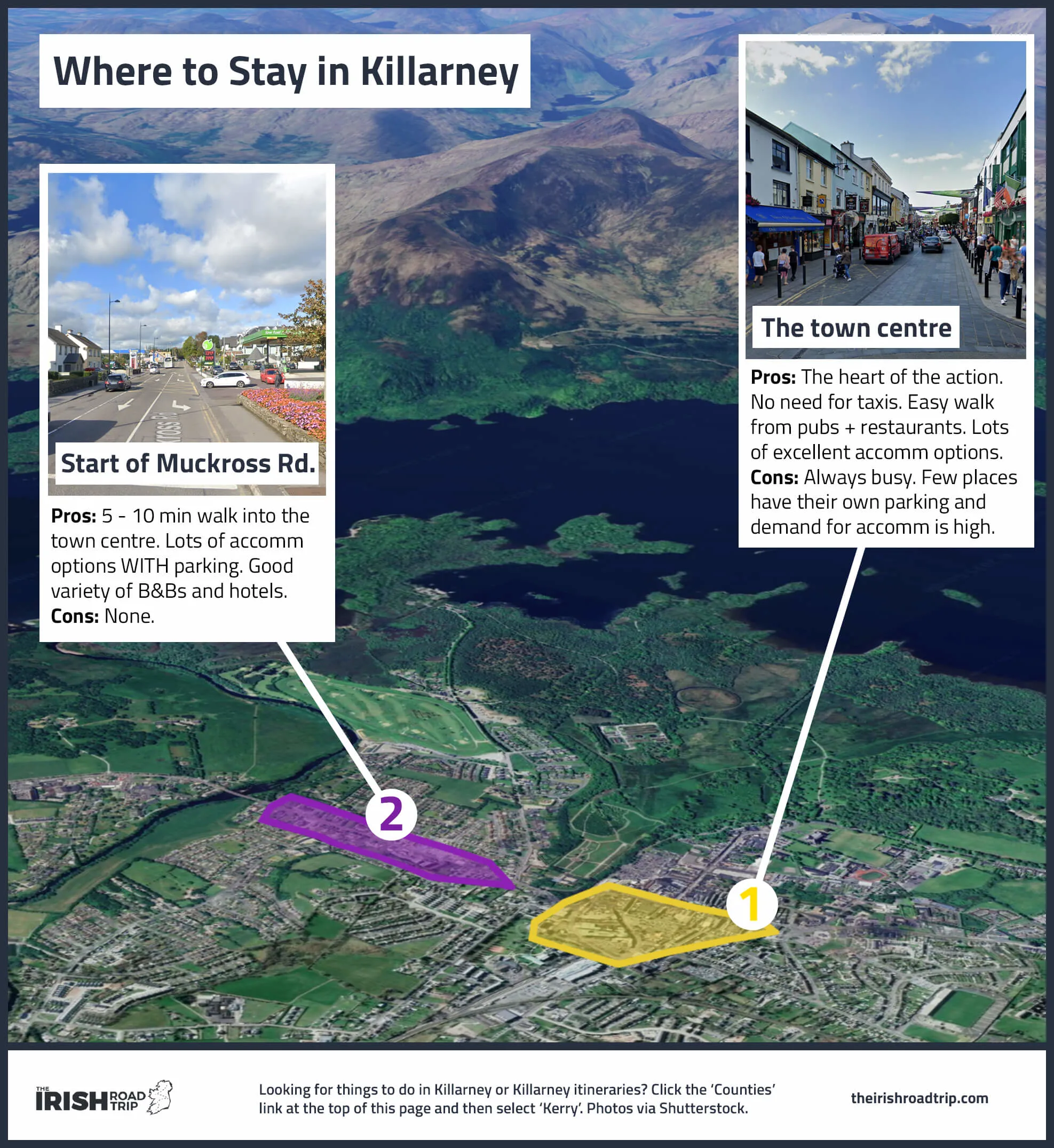
Day 2 is a big one, so I’d recommend hitting the road early. This tends to be the stand-out day for many that follow this route.
You’ll be travelling to Killarney and stopping at some very ancient landmarks along the way.
Where to stay in Killarney
- Budget: Kingdom Lodge (adjacent to the National Park) and Castle Lodge (charming B&B just outside the center)
- Mid-range: Killaran House (outstanding location in the heart of town) and Killarney Avenue (beside the park)
- Luxury: Muckross Park (prestigious 5-star hotel just outside town) and The Killarney Park (vintage charm near the train station)
An overview of the route

Here’s an overview of the stops:
- Rock of Dunamase (1 hour from Dublin): 9th-century castle ruins with glorious views (spend 35 minutes here)
- Rock of Cashel (50 minutes from Dunamase): Hilltop site with 12th-century cathedral and round tower (spend 1 hour here – tour is 45 minutes long)
- Cahir Castle (20 minutes from Cashel): 13th-century fortress on an island in the River Suir (spend 1 hour here – tour lasts 40 minutes)
- Killarney (1 hour and 50 minutes from Cahir): Your base for the next few nights
Stop 1: The Rock of Dunamase

Photos via Shutterstock
The Rock of Dunamase in County Laois is around a 1-hour drive from Dublin. You’ll see it from afar as it sits in an elevated position at 46 metres/151 feet.
There have been numerous fortifications on this site over the years, as was revealed by excavations that took place in the 1990s.
There was a hill fort during the 9th century and then, around 845, Dublin’s Vikings sieged the site.
The current castle, which was built during the 12 century, is now in ruin, but you can park here and then take a short but steepish walk up to it for a look around.
Stop 2: The Rock of Cashel
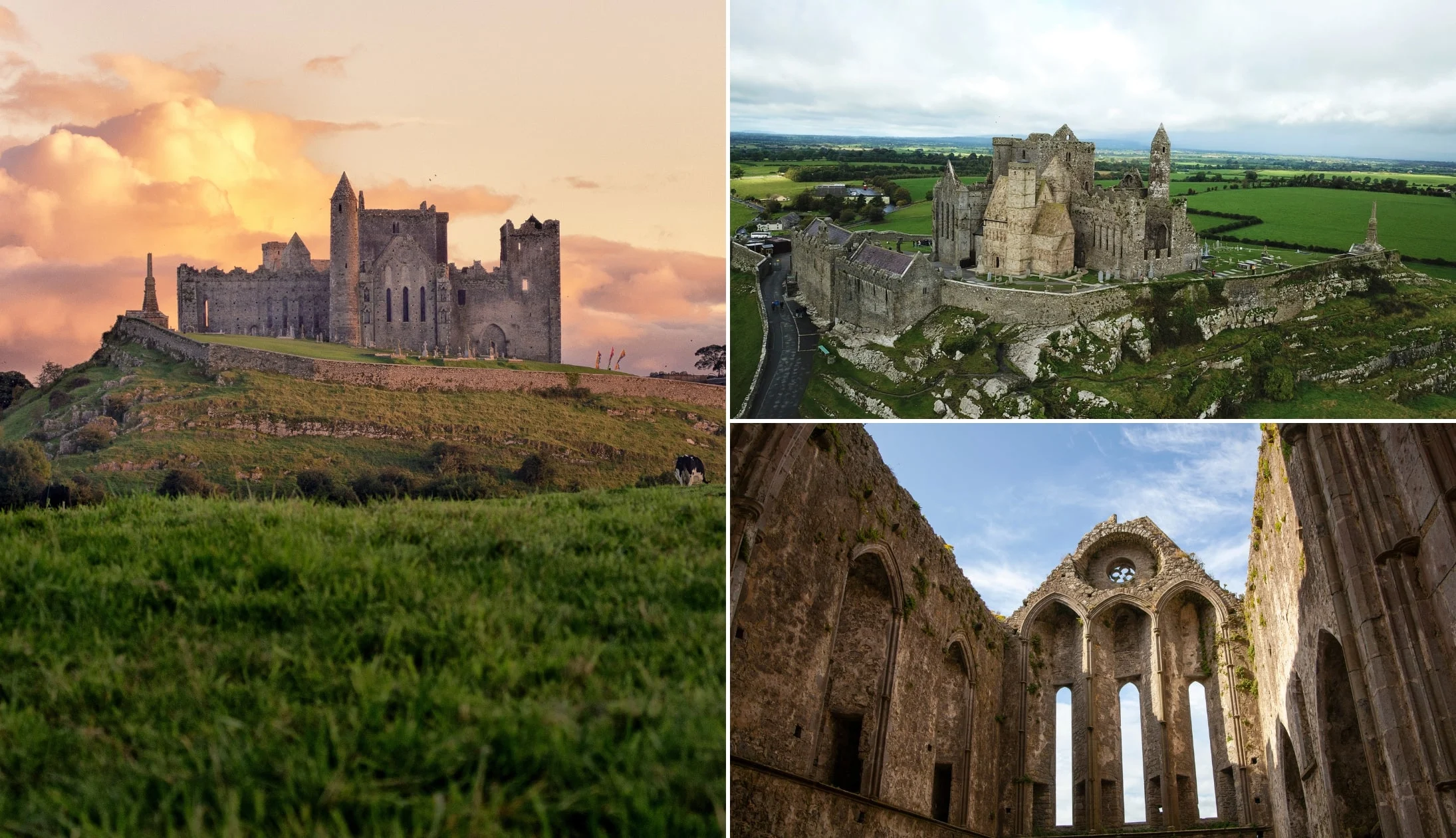
Photos via Shutterstock
The Rock of Cashel will be the highlight for many that follow this 3 days in Ireland itinerary.
It’s a 55-minute drive from Dunamase and, although it’ll break up your trip to Killarney, it’s a hugely rewarding stop.
The Rock of Cashel looms over the busy town of Cashel in Tipperary from its position on top of a limestone outcrop.
It was originally the seat of the Kings of Munster, but in 1101, it was given to the church. It quickly became one of Ireland’s most important ecclesiastical centres.
The Rock of Cashel tour: The 1-hour guided tour is extremely popular so make sure to book tickets in advance
Stop 3: Cahir Castle

Photos via Shutterstock
The incredible 13th-15th century Cahir Castle, which was once the stronghold of the Butler family, is widely regarded as one of the best-preserved castles in Ireland.
It can be found on a rocky island on the River Suir in Tipperary a 20-minute drive from Cashel.
The castle was skilfully designed to be a state-of-the-art defensive castle and, over the course of many years, it was rebuilt and extended. It wasn’t until 1599 that the castle reached its current state.
A visit to Cahir Castle will immerse you in the eventful history of the castle, from when it was built from 1142 by Conor O’Brien right the way up to when it was declared a national monument.
Stop 4: Arrive in Killarney and get checked in
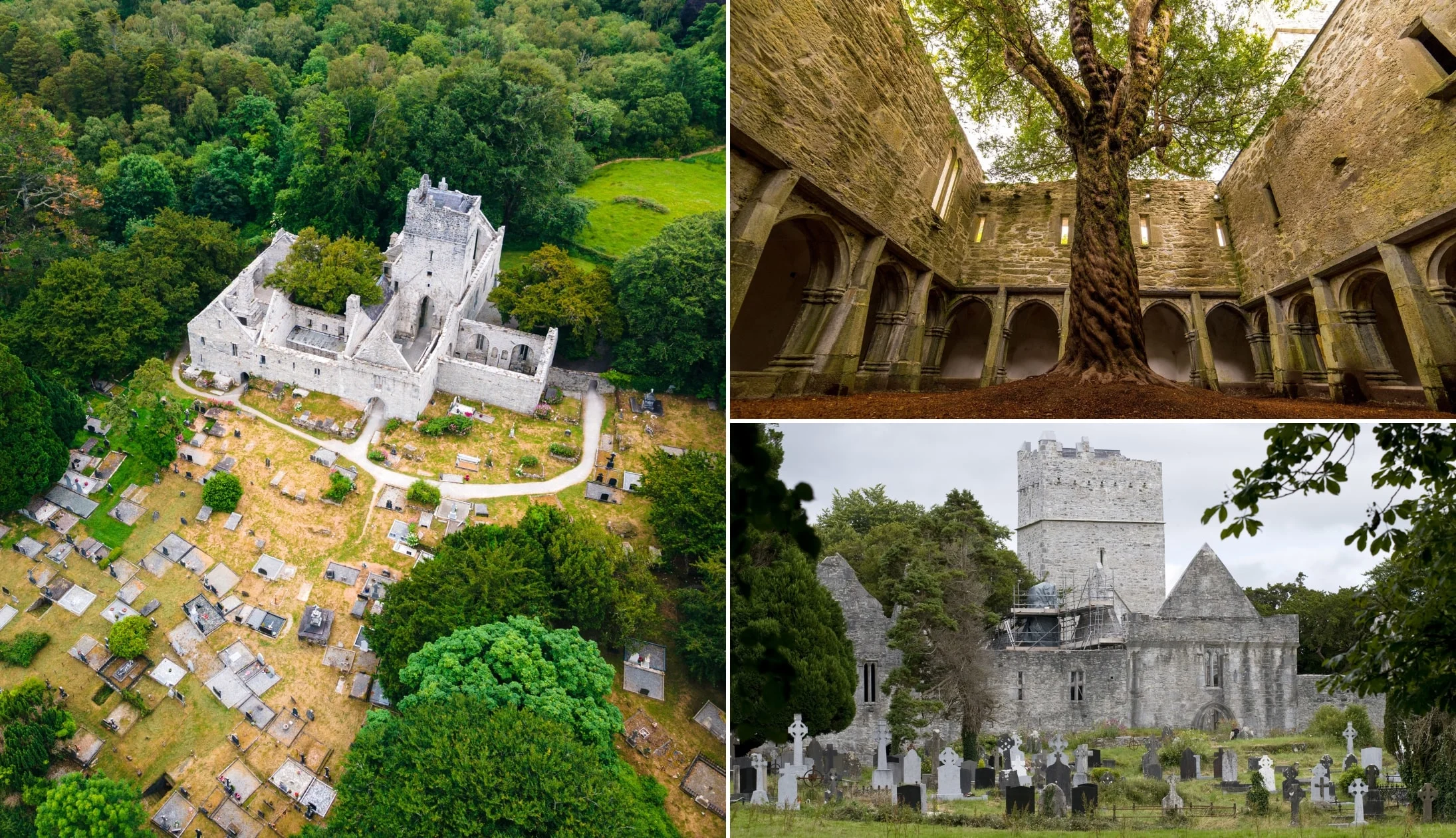
Photos via Shutterstock
It’s time to make your way to Killarney, a 1-hour and 50-minute drive from Cahir.
Check into your accommodation and then head out to explore Killarney National Park.
A mini Killarney itinerary to follow

I’d normally recommend that you rent a bike and head for a cycle around the various attractions in Killarney, but you’ll be here late afternoon and you won’t have a huge amount of time to play with.
So, your best bet is to drive. Here are the three stops that are well worth doing:
- B: Park at the 500+ year old Ross Castle and ramble around its grounds
- C: Drive to Muckross Abbey and explore its ancient ruins
- D: See Torc Waterfall
Killarney for the evening

Here’s some food and pub recommendations:
Dinner recommendations
There are some exceptional restaurants in Killarney. My favourites are:
- The Mad Monk (top-notch seafood like sizzling crab claws and deep water prawn tagliatelle)
- Kitty O’Se (splash out on the Seafood Tower to share)
- Murphy Browns (hearty Irish dishes like roasted duck and fish and chips).
Pub recommendations
There’s some mighty old-school pubs in Killarney, too. For post-dinner drinks, head to JM Reidy’s, the Laurels Pub, or O’Connors.
They all have a traditional pub feel and are a great choice for a pint. JM Reidy’s has a lovely courtyard which is great in the summer, and O’Connors is perfect if you feel like cocktails.
If you want to hear some live music, JM Reidy’s and O’Connors often have live music sessions.
Day 3: The Ring of Kerry Drive

I have a tried-and-tested (I’ve done it many times) 1-day Ring of Kerry itinerary that you can follow.
It takes in the best of Killarney National Park, first, before moving out and along the N70 road.
The Ring of Kerry map above shows the entire route but, as you visited the stops around the town the previous afternoon, you can skip straight to Ladies View!
Stop 1: Ladies View

The first stop in my Ring of Kerry guide takes us to the wonderful Ladies View. It got its name after Queen Victoria and Prince Albert visited in 1861.
It’s said that the Queen’s ‘ladies-in-waiting’ (i.e. personal assistants) were so taken by the view that it was named after them!
Park next to the viewing area, step out and soak up a view of the National Park and the Lakes of Killarney.
Stop 2: Moll’s Gap

The next stop on the Ring of Kerry drive is the mighty Moll’s Gap – a bendy pass that offers spectacular views of the Macgillycuddy’s Reeks.
You can park right next to it in the Avoca car park. It got its name from Moll Kissane who ran a Sibin (unlicensed pub) during the construction of the Killarney to Kenmare road in the 1820s.
She was well-liked in the area. Possibly due to the fact that she sold homemade Poitin to the men working on the road.
A handy tip for tourists: Planning a trip to Ireland can be a pain. In this guide, you’ll find 7 tried-and-tested steps to follow
Stop 3: Kenmare

Next up is Kenmare – a lovely little town that’s a lot quieter than Killarney (it’s also home to a handful of Ring of Kerry hotels!).
Although, there are plenty of things to do in Kenmare (like the stone circle), as this is a 1 day Ring of Kerry itinerary, I’m going to recommend you grab a coffee and head for a wander.
Aim for Henry Street (left in the photo above) to see the colourful shops and pubs that have graced many-a-postcard.
Stop 4: Staigue Stone Fort

Many driving the Ring of Kerry tend to miss Staigue Stone Fort but, as the reviews online will attest, it’s well worth a visit.
It’s thought that it was constructed during the late Iron Age (sometime between 300 and 400 AD) to act as a defensive structure, likely for a local king.
It was partly restored and you can walk inside it. There are some glorious views of the surrounding countryside from Staigue, too!
Stop 5: Lunch

Photos via the Blind Piper
This is one of the optional Ring of Kerry stops. You’ll likely need a feed at this point and, luckily enough, you’ll have to pass through Caherdaniel.
Head for the Blind Piper (a traditional pub), relax for a bit and fuel up with some hearty fare. There’s plenty more exploring to be done!
Stop 6: Derrynane Beach

You’ll find Derrynane Beach, one of the best beaches in Kerry, a short spin from the lunch spot and the perfect place to walk off your lunch!
Derrynane is reasonably sheltered and boasts a natural harbour. Keep an eye out for the ruins of Derrynane Abbey (believed to date to the 6th century) as you saunter along the sand.
This is one of the most frequently missed Ring of Kerry stops, but it’s well worth the short detour.
Stop 7: Coomakista viewpoint

One of the best things about driving the Ring of Kerry is the endless Wild Atlantic Way discovery points that you stumble upon.
One of the most popular is the Coomakista viewpoint. There’s plenty of parking here and, on a clear day, you’ll have unbeatable views of Deenish and Scariff islands.
Stop 8: The Skellig Ring

If you look at my Ring of Kerry map with stops above you’ll see that we’re now entering the Skellig Ring.
There are a number of stops along this section of the route that you can either admire from afar or stop off at.
When you leave Coomakista, you’ll reach ‘Scenic Point’ (here on Maps), followed by Waterville (a favourite of Charlie Chaplin) and then Ballinskelligs (home to a beach and a castle)
From there, you have the Skelligs Telescope Viewpoint, St. Finian’s Bay and then, finally, the magnificent Coomanaspig viewpoint that leads to the next stop.
Stop 9: The Kerry Cliffs

Next up is another spot that’s missed by many driving the Ring of Kerry – the 1,000 ft high Kerry Cliffs.
The cliffs, which are believed to be over 400 million years old, are reached via private land (I think it was €5/6 when I was here last). It’s a steep 10-minute walk up to the view point but it’s well worth the effort.
Although Clare’s Cliffs of Moher and Donegal’s Slieve League get much of the attention from tourists, the Kerry Cliffs are strong contenders for Ireland’s most impressive cliffs.
Stop 10: Geokaun Mountain

The next stop on my Ring of Kerry road trip is Valentia Island (connected to Portmagee village by the Maurice O’Neill Memorial Bridge).
When you arrive on the island, head up to the car park near Bray Head. You’ll get an eyeful of the Skellig Islands from here. When you’re done here, make your way up to the Geokaun Mountain and Cliffs.
There’s a €5/6 entry fee and then you take the very steep ‘road’ to the viewing area. It’s from here that you’ll get one of the finest views on the Ring of Kerry drive.
You’ll see everything from Knightstown below to the Dingle Peninsula off in the distance.
Stop 11: Dinner in Portmagee

Photos via the Moorings
Next is another of the optional Ring of Kerry stops, but it’ll likely be dinner time when you reach this point so head to Portmagee.
One of the best options food-wise in this little village is the Moorings. Head in and fuel up for the final section of the Ring of Kerry route.
Stop 12: Rossbeigh Beach

The last stop on my Ring of Kerry route is the beautiful Rossbeigh Beach. Now, if you want you can stop in Cahersiveen en route to Rossbeigh (refer to my Ring of Kerry map for ideas on what to do).
However, as it’s getting late in the day, we’re going to power on. Rossbeigh Strand is one of the more popular beaches near Killarney and there’s plenty of parking.
This is a lovely stretch of sand for a ramble, especially after the long drive from Portmagee.
A handy tip for tourists: Renting a car in Ireland can be stressful. In this guide, you’ll discover what pitfalls to avoid
Stop 13: Pints in Killarney

When you finish up at Rossbeigh, it’s time to head on to Killarney, and it’s here that this Ring of Kerry itinerary comes to an end.
- Restaurants in Killarney: Cronins, Porterhouse and the Mad Monk never disappoint
- Pubs in Killarney: O’Connors and Jimmy Brien’s are two great spots for a pint
- Live music: Murphy’s Bar and J.M. Reidy’s and two good shouts for live tunes
Our most useful guides for planning your Irish Road Trip
And that’s a wrap on this road trip. Remember, you’ll find every length and type of road trip imaginable in our Irish Road Trip Hub.
If you’re in the middle of planning your visit, these guides should prove useful:
- Planning tips: 7 steps that make planning a trip to Ireland stress free
- When to visit: The pros and cons of every month in Ireland
- Weather: An overview of the weather in Ireland by month
- Airports: Where you can fly into
- Ireland Trip cost: What impacts the cost of a trip to Ireland
- Getting around: The pros and cons of seeing Ireland with a car vs by bus/train
- Car rental: A bs-free guide to renting a car in Ireland
- What not to do: 17 things to avoid doing in Ireland
- Tips: When and how much to tip in Ireland
- What to wear: A guide on what to pack for each month
- Budget travel: How to do Ireland on a budget

